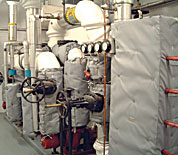| |
Estimating Budget and Finalizing Design

|
|
A rough quotation and budget estimate should be available to the buyer following receipt of an outline specification listing what removable-reusable insulations are needed. This can be further developed through discussions with the supplier. To augment this, quality removable-reusable insulation manufacturers should be able to conduct a site survey and present an estimate or quotation on larger (and sometimes smaller) jobs.
During a site review, the manufacturer will make site measurements and take notes of the operating parameters, operating conditions, physical location, dimensions, heat tracing, space constraints and adjacent equipment and processes. From this information, a design sketch will be produced.
The information on the design sketch and site measurements will allow the design to be completed. It should be noted that thorough, skillful design is essential to manufacturing a functional and well-fitting removable-reusable insulation system. This information is then transferred to a design and manufacturing sheet, which forms the manufacturing specification and goes to the layout and cutting table. It shows layout and dimensions for the liner, insulation layer, jacket, closures, and miscellaneous gussets. It also should show the materials to be used and the manufacturing inspection points and requirements.
Manufacturing
Again, it's critical that professional, experienced full-time production staff lay out, cut, assemble, sew and inspect the liner, insulation layer and jacket into the final removable-reusable insulation piece. This is a highly skilled job, and the final product should fit like a kid glove or a Saville Row suit. If it doesn't, something is wrong. The methods of joining the various parts of removable-reusable insulations together have become increasingly sophisticated. Top quality covers will now be more inclined to be sewn instead of hog-ringed together. Extremely durable high-tech threads, including Kevlar-coated stainless steel thread, Teflon-coated glass, polyester, and plain Kevlar threads are available for this task.
The picture shows some of the design layout and quality control inspections being undertaken on a partly finished insulation piece. The complexity of manufacture is reasonably evident in the picture. Overlapping flaps are visible, showing the detail needed to help keep the elements and errant fluids out, and the inner insulating layer dry.
There are many other nuances of design and manufacture of first-rate removable-reusable insulations that extend far beyond the space available for this article. These all come from field and manufacturing experience and are integrated into designs by experienced manufacturers.
Finishing
Finishing of removable-reusable insulations is also very important to long life and durability. Some finishing operations include labeling, along with integrating quilting pins into the finished product. Using quilting pins is important. These prevent the internal insulation layer from shifting between the inner liner and outer jacket. If electric tracing is present, or no abrasion is allowed against the insulated face of the equipment, then the quilting pins may be capped with "dome" caps to prevent damage to the tracing or equipment surface.
Finally, identification of the individual pieces of a removable-reusable insulation system is important. The labeling should be durable and strongly attached. Embossed metal plates meet these criteria. Information included on the labeling might include the manufacturer name, the job number and the customer purchase order number. It might also include the manufacturer's piece number tied back its quality management records, the process system on which the removable-reusable insulation system will be installed, and the particular piece of equipment on which the removable-reusable insulation piece will be installed and remain.
Labeling is important since, when the in-field design sketch was made, the closures on one piece of insulation may have been placed in a different orientation than another piece, even though it's fitted on identical equipment. This choice of closure orientation, for example, may be due to such factors as interference with adjacent equipment, or placement of the closure such that it's oriented for easy access for maintenance, particularly if above grade. Other factors may include identical valves having their bonnets rotated and installed at different orientations on the bolt-circle pattern. The nuances are too great to mention here, but must be considered. These are the hallmarks of a professional manufacturer.
A formal quality management system should be in place to ensure consistency of manufacture of removable-reusable insulation. That there should be full manufacturer support through all phases of specification, design, delivery, installation, and after sale support shouldn't even be a question. It's essential to customer satisfaction and durable well-designed products.
|
|

